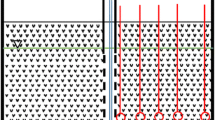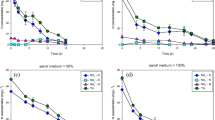Abstract
Due to its high usage, mobility, and recalcitrant nature, atrazine is a common groundwater contaminant. Moreover, groundwaters that are contaminated with atrazine often contain nitrate as well. Nitrate interferes with the biological degradation of atrazine and makes it more difficult to use in situ biological methods to remediate atrazine contaminated groundwater. To solve this problem we used two reactors in sequence as models of in situ biobarriers; the first was a vegetable-oil-based denitrifying biobarrier and the second an aerobic reactor that oxygenated the denitrifying reactor’s effluent. The reactors were inoculated with an atrazine-degrading microbial consortium and supplied with water containing 5 mg l−1 nitrate–N and 3 mg l−1 atrazine. Our hypothesis was that the denitrifying barrier would remove nitrate from the flowing water and that the downstream reaction would remove atrazine. Our hypothesis proved correct; the two reactor system removed 99.9% of the atrazine during the final 30 weeks of the study. The denitrifying barrier removed ~98% of the nitrate and ~30% of the atrazine while the aerobic reactor removed ~70% of the initial atrazine. The system continued to work when the amount of nitrate–N in the influent water was increased to 50 mg l−1. A mercury poisoning study blocked the degradation of atrazine indicating that biological processes were involved. An in situ denitrifying barrier coupled with an air injection system or other oxygenation process might be used to remove both nitrate and atrazine from contaminated groundwater or to protect groundwater from an atrazine spill.




Similar content being viewed by others
References
Dixit V, Bini E, Drozda M, Blum P (2004) Mercury inactivates transcription and the generalized transcription factor TFB in the Archaeon Sulfolobus solfataricus. Antimicrobial Agents Chemother 48:1993–1999
Gammon DW, Aldous CN, Carr WC Jr, Sanborn JR, Pfelfer KF (2005) A risk assessment of atrazine use in California: human health and ecological aspects. Pest Manag Sci 61:331–335
Greenburg AE, Clesceri LS, Eaton AD (eds) (1992) Standard methods for the examination of water and wastewater, 18th edn. Sect. 8010 C. Basic requirements for toxicity tests. American Public Health Association, American Water Works Association and Water Environmental Federation, Washington, DC
Health-Canada (1993) Environmental and workplace health. http://www.hc-sc.gc.ca/ewh-semt/pubs/water-eau/doc_sup-appui/atrazine/index_e.html#10
Hunter WJ (2001) Use of vegetable oil in a pilot-scale denitrifying barrier. J Contam Hydrol 53:119–131
Hunter WJ, Shaner DL (2009) Nitrogen limited biobarriers remove atrazine from contaminated water: laboratory studies. J Contam Hydrol 103:29–37
Hunter WJ, Follett RF, Cary JW (1997) Use of vegetable oil to stimulate denitrification and remove nitrate from flowing water. Trans ASAE 40:345–353
Lee MD, Borden B, Lieberman MT, Beckwith W, Crotwell T, Haas PE (2001) Effective distribution of edible oils—results from five field applications. In: Magar VS, Fennell DE, Morse JJ, Alleman BC, Leeson A (eds) Anaerobic degradation of chlorinated solvents. Battelle Press, Columbus, pp 249–256
Manske MK, Beltz LA, Dhanwada KR (2004) Low-level atrazine exposure decreases cell proliferation in human fibroblasts. Arch Environ Contamin Ttoxicol 6:438–444
Radosevich M, Traina SJ, Hao Y-L, Tuovinen OH (1995) Degradation and mineralization of atrazine by a soil bacterial isolate. Appl Environ Microbiol 61:297–302
United States Environmental Protection Agency (USEPA) (2006) Decision Documents for atrazine [Online]. Available at http://www.epa.gov/oppsrrd1/REDs/atrazine_combined_docs.pdf. (verified January 2, 2009)
Acknowledgments
The authors thank Robin Montenieri, Kimberly LaCroix, and Doug Barlin for their expert technical assistance. Manufacturer and product brand names are given for the reader’s convenience and do not reflect endorsement by the US government. This article was the work of US government employees engaged in official duties and is exempt from copyright.
Author information
Authors and Affiliations
Corresponding author
Rights and permissions
About this article
Cite this article
Hunter, W.J., Shaner, D.L. Biological Remediation of Groundwater Containing Both Nitrate and Atrazine. Curr Microbiol 60, 42–46 (2010). https://doi.org/10.1007/s00284-009-9499-3
Received:
Revised:
Accepted:
Published:
Issue Date:
DOI: https://doi.org/10.1007/s00284-009-9499-3




